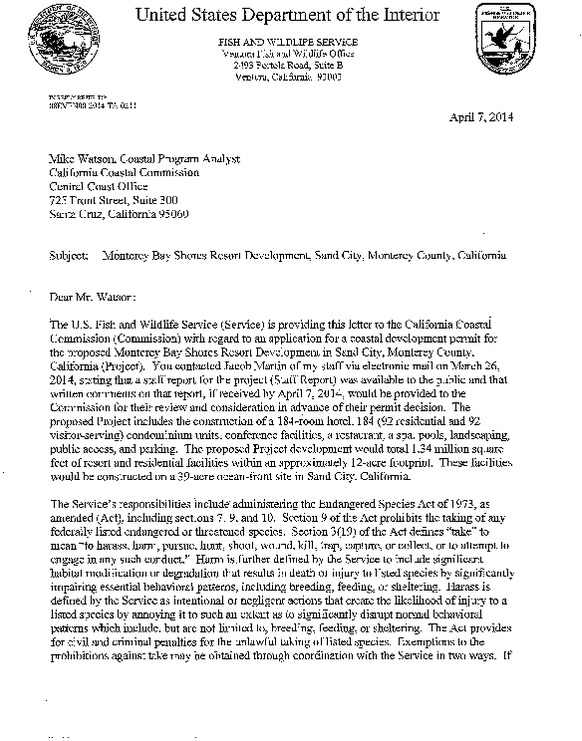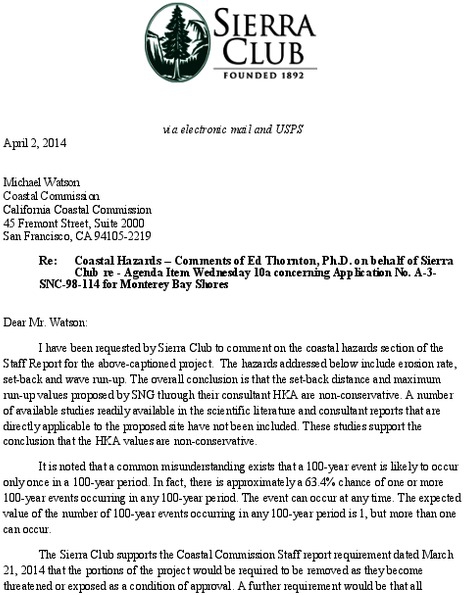From the Open-Publishing Calendar
From the Open-Publishing Newswire
Indybay Feature
Approval of Sand City Resort and Condominium Project Undermines Rare Species Recovery Plan
On April 10, on the second day of a 9 hour hearing, the California Coastal Commission gave conditional approval to the proposed Monterey Bay Shores Resort in Sand City. This project has been contested by the Sierra Club since it was first proposed in 1998. The development would put a 1.3 million square foot, 368 unit hotel and condominium complex with underground parking spaces for nearly 1,000 cars into the fragile dune landscape of the Monterey Bay National Marine Sanctuary. Nearly 700,000 cubic yards of dune sand or 73% of the habitat would be disturbed by bulldozers and trucks. The site is wedged in between a State Park and a Regional Park as well as nearby to another proposed hotel site. The Commission has twice before denied this project a Coastal Development Permit. However after a complex series of lawsuits, the Commission, under pressure from the Attorney General's office, decided to grant the permit with conditions.
The proposed building site is within the highly unstable Monterey dune ecosystem and it harbors three federally listed endangered species, the Pacific coast population of the Western Snowy Plover, the Smith's Blue Butterfly and the Monterey Spineflower. An April 7th letter from the U.S. Fish and Wildlife Service (see PDF) states that about one third of the site is within designated critical habitat for the Western Snowy Plover. The Service calculates that the project will result in 88% of the habitat being disturbed above the high tide line and 38% being permanently destroyed by construction. This habitat degradation may constitute harm to the species if there is loss to coastal plover populations and may result in a "Take" as defined under Section 3 (19) of the Endangered Species Act (ESA).
The plover currently nests in the sand, both on the beach and in the dune areas of the proposed site. A tiny beach bird, it weighs less than 2 ounces. Once the eggs hatch, the chicks, unable to fly for a month, soon begin to wander the beach feeding off insects under the watchful eyes of their parents. Plover chicks often feed at the high water debris line, called the "wrack line" near the edge of the extent of high tide waves. As Snowy Plovers are so small, they cannot protect their chicks from this massive increase in the presence of humans, pets, vehicles and human-activity attracted predators that will access the beach from this new development. A hotel/condo project with hundreds of guests and year-round residents sited directly within plover critical habitat is a major problem for this rare species. There are only about 2,200 of these birds left in all of coastal California.
The torturous lengthy hearing was taken up by back and forth arguments between the developer, his attorney, and the Commission. These discussions centered on the conditions the Commission staff had recommended be placed upon the permit. These "conditions" ranged between limits upon night lighting and windows (that lead to bird strike kills) to a contentious argument about how to build foundations that are expected to be undermined by shoreline erosion and sea level rise.
In other words this hotel/condo proposal is expected to be eventually washed away by the Pacific Ocean and the Coastal Commission staff did not want to recommend approval of a permit that would leave behind concrete foundations buried in the beach. One condition requires that parts of the hotel/condo project be removed once breaking waves come within a short distance of the hotel. (See PDF of Coastal Engineer Dr. Thornton's erosion analysis).
The developer has proposed his own plan to protect habitat for wildlife and rare plants; however experts engaged by the Sierra Club disputed the practicality and effectiveness of the developer's plan. We regard this plan as a smoke screen meant primarily to confuse the issues. It is clear to us that this hotel/condo project will be very destructive to wildlife and rare plants. Structures that are expected to be washed away should not be built in the first place. Sierra Club will continue our efforts to protect wildlife and stop this project from being built.
http://ventana.sierraclub.org/conservation/coastaldunesresort/index.shtml
The plover currently nests in the sand, both on the beach and in the dune areas of the proposed site. A tiny beach bird, it weighs less than 2 ounces. Once the eggs hatch, the chicks, unable to fly for a month, soon begin to wander the beach feeding off insects under the watchful eyes of their parents. Plover chicks often feed at the high water debris line, called the "wrack line" near the edge of the extent of high tide waves. As Snowy Plovers are so small, they cannot protect their chicks from this massive increase in the presence of humans, pets, vehicles and human-activity attracted predators that will access the beach from this new development. A hotel/condo project with hundreds of guests and year-round residents sited directly within plover critical habitat is a major problem for this rare species. There are only about 2,200 of these birds left in all of coastal California.
The torturous lengthy hearing was taken up by back and forth arguments between the developer, his attorney, and the Commission. These discussions centered on the conditions the Commission staff had recommended be placed upon the permit. These "conditions" ranged between limits upon night lighting and windows (that lead to bird strike kills) to a contentious argument about how to build foundations that are expected to be undermined by shoreline erosion and sea level rise.
In other words this hotel/condo proposal is expected to be eventually washed away by the Pacific Ocean and the Coastal Commission staff did not want to recommend approval of a permit that would leave behind concrete foundations buried in the beach. One condition requires that parts of the hotel/condo project be removed once breaking waves come within a short distance of the hotel. (See PDF of Coastal Engineer Dr. Thornton's erosion analysis).
The developer has proposed his own plan to protect habitat for wildlife and rare plants; however experts engaged by the Sierra Club disputed the practicality and effectiveness of the developer's plan. We regard this plan as a smoke screen meant primarily to confuse the issues. It is clear to us that this hotel/condo project will be very destructive to wildlife and rare plants. Structures that are expected to be washed away should not be built in the first place. Sierra Club will continue our efforts to protect wildlife and stop this project from being built.
http://ventana.sierraclub.org/conservation/coastaldunesresort/index.shtml
Add Your Comments
We are 100% volunteer and depend on your participation to sustain our efforts!
Get Involved
If you'd like to help with maintaining or developing the website, contact us.
Publish
Publish your stories and upcoming events on Indybay.
Topics
More
Search Indybay's Archives
Advanced Search
►
▼
IMC Network




